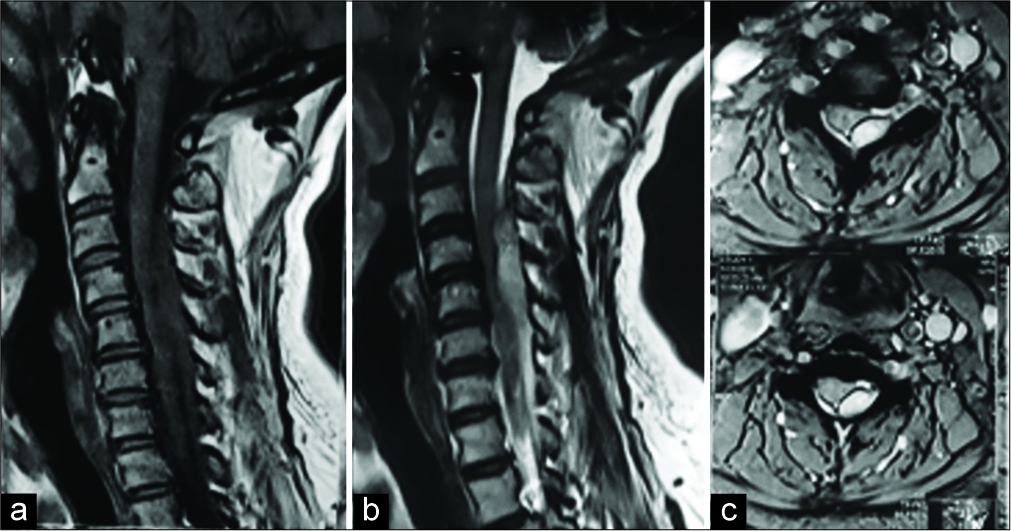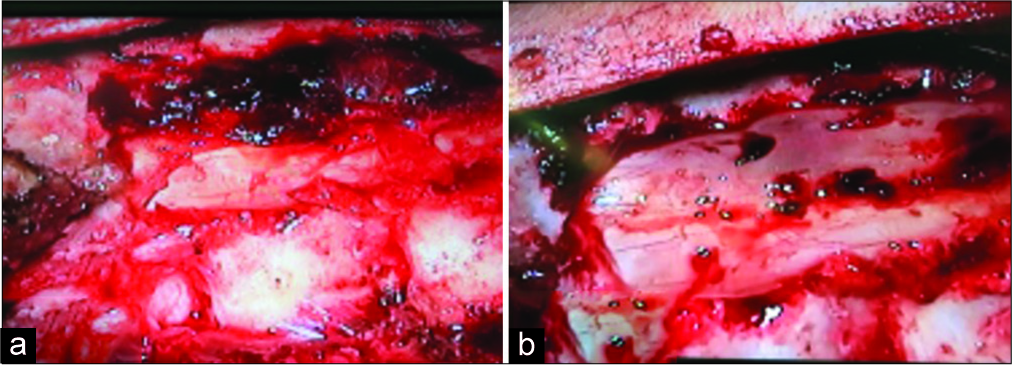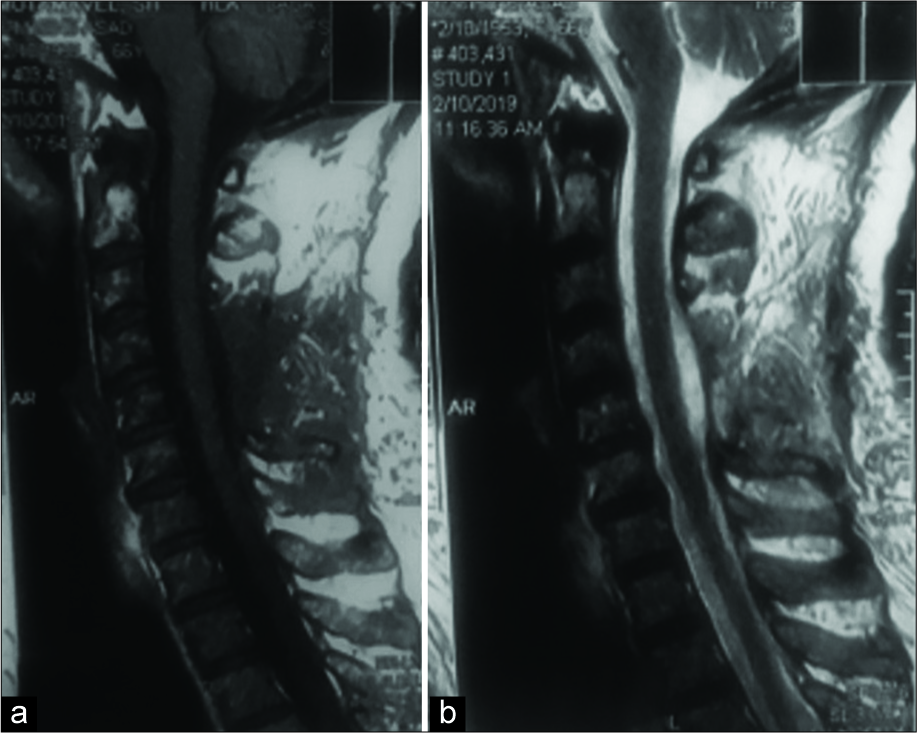- Pars Advanced and Minimally Invasive Medical Manners Research Center, Pars Hospital, Iran University of Medical Sciences, Tehran, Iran.
DOI:10.25259/SNI_390_2019
Copyright: © 2019 Surgical Neurology International This is an open-access article distributed under the terms of the Creative Commons Attribution-Non Commercial-Share Alike 4.0 License, which allows others to remix, tweak, and build upon the work non-commercially, as long as the author is credited and the new creations are licensed under the identical terms.How to cite this article: Abolfazl Rahimizadeh, Zahed Malekmohammadi, Walter L. Williamson, Shaghayegh Rahimizadeh, Mahan Amirzadeh, Naser Asgari. Rivaroxaban-induced acute cervical spine epidural hematoma: Report of a case and review. 25-Oct-2019;10:210
How to cite this URL: Abolfazl Rahimizadeh, Zahed Malekmohammadi, Walter L. Williamson, Shaghayegh Rahimizadeh, Mahan Amirzadeh, Naser Asgari. Rivaroxaban-induced acute cervical spine epidural hematoma: Report of a case and review. 25-Oct-2019;10:210. Available from: http://surgicalneurologyint.com/surgicalint-articles/9723/
Abstract
Background: Spontaneous spinal epidural hematomas (SEHs) due to the utilization of factor Xa inhibitors are rare.
Case Description: A 66-year-old female presented with a Brown-Sequard syndrome attributed to a cervical epidural hematoma secondary to the utilization of rivaroxaban, one of the factor Xa inhibitors. Following a cervical laminectomy for the evacuation of the hematoma, the patient completely recovered.
Conclusion: A spinal hemorrhagic event should be suspected in patients receiving factor Xa inhibitor drugs. Here, we had an elderly female on rivaroxaban experienced the acute onset of neck/back pain associated with a Brown-Sequard syndrome. A literature review showed that this is the seventh example of SEH occurring as a result of the use of anticoagulation drugs (OACDs; e.g., including Xa inhibitors).
Keywords: Anticoagulant, Factor Xa inhibitors, Rivaroxaban, Spinal epidural hematoma
INTRODUCTION
Factor Xa inhibitor drugs, the newer oral anticoagulants, are increasingly utilized for the prevention of stroke in nonvalvular atrial fibrillation and the prevention/treatment of DVT and pulmonary emboli.[
CASE REPORT
A 66-year-old female presented acutely with neck pain/back pain and a classic Brown-Sequard syndrome of 1 day’s duration. The patient was taking rivaroxaban (15 mg, daily) and low-dose aspirin for atrial fibrillation. An emergent cervical MRI disclosed a dorsal-lateral C3-C6 cervical epidural mass. It was isointense on T1 weighted and hyperintense on T2-weighted MRIs; these findings were compatible with an acute cervical/SHE [
DISCUSSION
Etiology of SEH with Xa inhibitors
Factor Xa inhibitors are newer oral anticoagulant drugs which block thrombin formation, prevent conversion of fibrinogen to fibrin, and, hence, inhibit thrombus formation.[
Literature review of SEH occurring with factor Xa
A review of literature revealed that factor Xa inhibitor- induced SEH is mostly seen in the elderly and more so in females rather than males [
Treatment of SEH due to factor Xa
The management of SEH depends on the volume of the hematoma and the rapidity/severity of the neurological symptoms/signs.[
Optimal surgical timing
Early recognition and surgical intervention for SEHs with neurologic compromise remain key to achieving a favorable outcome.[
Optimal time for restarting anticoagulant
In one study, the optimal timing for readministration of Xa anticoagulants was 2–3 weeks postoperatively.[
CONCLUSION
For patients receiving factor Xa inhibitors, SEH should be included in the differential diagnosis where patients develop acute spinal/back pain and the onset of a significant neurological deficit. Performing immediate MR scans to document the location and severity of the SEH are critical. While those with lesser symptoms/signs may be managed conservatively, patients with significant neurological deficits may warrant urgent/emergent clot removal.
Declaration of patient consent
The authors certify that they have obtained all appropriate patient consent forms.
Financial support and sponsorship
Nil.
Conflicts of interest
There are no conflicts of interest.
References
1. Bamps S, Decramer T, Vandenbussche N, Verhamme P, Thijs V, Van Loon J. Dabigatran-associated spontaneous acute cervical epidural hematoma. World Neurosurg. 2015. 83: 257-8
2. Goldfine C, Glazer C, Ratzan RM. Spontaneous spinal epidural hematoma from rivaroxaban. Clin Pract Cases Emerg Med. 2018. 2: 151-4
3. Goyal G, Singh R, Raj KJ. Anticoagulant induced spontaneous spinal epidural hematoma, conservative management or surgical intervention a dilemma?. J Optoelectron Adva Mater. 2016. 6: 38-42
4. Groen RJ, van Alphen HA. Operative treatment of spontaneous spinal epidural hematomas: A study of the factors determining postoperative outcome. Neurosurgery. 1996. 39: 494-508
5. Ismail R, Zaghrini E, Hitti E. Spontaneous spinal epidural hematoma in a patient on rivaroxaban: Case report and literature review. J Emerg Med. 2017. 53: 536-9
6. Jaeger M, Jeanneret B, Schaeren S. Spontaneous spinal epidural haematoma during factor xa inhibitor treatment (Rivaroxaban). Eur Spine J. 2012. 21: S433-5
7. Kirazli Y, Akkoc Y, Kanyilmaz S. Spinal epidural hematoma associated with oral anticoagulation therapy. Am J Phys Med Rehabil. 2004. 83: 220-3
8. Ozel O, Demircay E, Kircelli A, Cansever T. Atypical presentation of an epidural hematoma in a patient receiving rivaroxaban after total hip arthroplasty. Orthopedics. 2016. 39: e558-60
9. Radcliff KE, Ong A, Parvizi J, Post Z, Orozco F. Rivaroxaban-induced epidural hematoma and cauda equina syndrome after total knee arthroplasty: A case report. Orthop Surg. 2014. 6: 69-71
10. Trujillo T, Dobesh PP. Clinical use of rivaroxaban: Pharmacokinetic and pharmacodynamic rationale for dosing regimens in different indications. Drugs. 2014. 74: 1587-603









